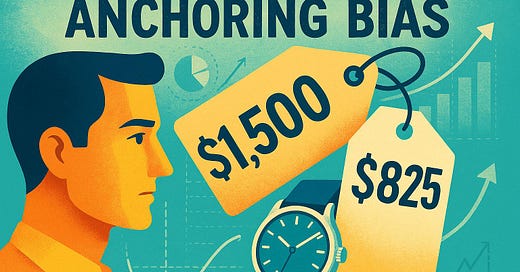Listen to a podcast-style discussion of this article or download it here
The Price Tag Illusion
Marcus stood in the high-end watch boutique, his eyes fixed on a gleaming timepiece behind the glass. The stainless steel watch with its intricate complications and blue dial spoke to him on a visceral level. The price tag read $1,500—more than he had planned to spend, but the craftsmanship was undeniable. He reluctantly walked away, promising himself he'd think about it.
Later that afternoon, wandering through a department store, Marcus spotted a remarkably similar watch. The design wasn't identical, but close enough that it stirred the same emotional response. When he checked the price tag—$825—his heart raced with excitement. What luck! It was practically the same watch at almost half the price!
Without hesitation, Marcus pulled out his credit card. As the sales associate processed his purchase, Marcus felt a surge of satisfaction—he'd scored an incredible deal.
What Marcus didn't realize was that he had fallen victim to a powerful psychological trap. The $1,500 watch had become an anchor in his mind, making the $825 watch seem like a bargain by comparison. But what was the $825 watch actually worth? Was $825 itself a fair price? Marcus never investigated the market value of either watch or considered alternatives in the $825 price range. He didn't research the brand reputation, movement quality, or resale value. The initial $1,500 price had become the reference point against which all subsequent decisions were measured.
If I want you to pay $600 for something, it would certainly be smart of me to initially offer the thing to you for $1200 and then point out to you that I am making a big concession by sliding down $600. I might even have some kind of sign like the below:
Understanding Anchoring Bias
Anchoring bias refers to our tendency to rely heavily on the first piece of information we encounter (the "anchor") when making decisions. This cognitive bias, first identified by psychologists Amos Tversky and Daniel Kahneman in the 1970s, operates largely beneath our conscious awareness, yet profoundly affects our judgment.
The psychology behind anchoring is both fascinating and troubling. When we encounter a number or value—even one that's completely arbitrary—it creates a reference point in our minds. Subsequent information gets evaluated in relation to this anchor rather than being assessed independently on its own merits.
What makes anchoring particularly powerful is that it persists even when we're aware of it. In one famous experiment, Tversky and Kahneman asked participants to spin a wheel with numbers from 0 to 100 (which was secretly rigged to land on either 10 or 65). After seeing their number, participants were asked to estimate the percentage of African countries in the United Nations. Those who saw the number 10 guessed an average of 25%, while those who saw 65 estimated 45%—demonstrating how an entirely random and irrelevant number influenced their judgment (Tversky & Kahneman, 1974).
In the financial world, anchoring can be particularly consequential. When making investment decisions, we often anchor to arbitrary numbers like purchase prices, historical highs, or even rounded figures, leading to potentially costly errors in judgment.
Anchoring in Investment Decisions
Initial Purchase Price
Perhaps the most common anchor for investors is the price at which they originally purchased a security. This number becomes psychologically significant, serving as a reference point against which all future price movements are measured.
Consider how differently investors react to a stock trading at $50 that was purchased at $30 versus the exact same stock at $50 purchased at $70. In the first scenario, the investor feels successful—the investment shows a gain. In the second, they feel like they're losing, even though the actual value and future prospects of the stock are identical in both cases.
As noted by behavioural finance expert Meir Statman, "People's emotional reactions to gains and losses relative to reference points lead them to view investments as being in the black or in the red, and they mentally account for them in separate buckets".
52-Week Highs and Lows
Market participants frequently anchor to a stock's 52-week high or low price. These figures are prominently displayed on financial websites and apps, making them easily accessible reference points.
A stock trading 30% below its 52-week high might seem like a bargain, prompting investors to buy based on the perception that it's "on sale." Conversely, a stock approaching its 52-week high might appear "expensive," causing investors to hesitate even if fundamental analysis suggests further growth potential.
Research published in the Journal of Finance found that 52-week highs serve as powerful psychological anchors, with stocks approaching these levels experiencing increased attention and trading volume (George & Hwang, 2004).
Media Influence and Analyst Targets
The financial media and analyst community create anchors daily through headlines, price targets, and forecasts. When a respected analyst sets a $400 price target on a stock currently trading at $300, that $400 figure becomes an anchor that shapes investors' expectations.
Similarly, round numbers serve as psychological anchors in market dynamics. We see increased trading activity around levels like $100, $500, or $1,000, as these figures take on outsized importance in investors' minds.
Real-Life Examples
Case Study 1: The Sunk Cost Trap
James, a retail investor, purchased shares in a renewable energy company at $75 per share in 2021, excited about the growth potential in the green energy sector. Over the following year, the company faced regulatory challenges and rising interest rates, causing the stock to decline to $45.
Despite deteriorating fundamentals and a changed market environment, James refused to sell. "I'll wait until it gets back to $75," he told his investment club, "then I can get out without a loss."
This thinking represents a classic anchoring error. James anchored to his purchase price rather than evaluating whether, at $45, the stock represented a good investment going forward. His decision-making was backward-looking, focused on recovering his "loss" rather than optimizing future returns.
Two years later, the company's stock was trading at $30, having never recovered to James's anchor price. Had he objectively reassessed the investment at $45 instead of anchoring to $75, he could have redeployed capital more effectively.
Case Study 2: Missing the Upside
Emma had been researching artificial intelligence companies in 2020 and identified a promising stock trading at $120. She added it to her watchlist but decided to wait for a pullback to $100 before buying. The stock continued to perform well, reaching $150, then $200.
"I'm not buying now," Emma reasoned. "I've been watching it since it was $120. It's too expensive."
Two years later, the stock was trading at $450, and Emma had missed the entire move. Her anchor of $120 prevented her from objectively assessing whether the stock represented good value at $150 or $200, despite strengthening fundamentals and market position.
According to research from Vanguard, this behaviour is common among investors. Their study found that investors who anchor to past prices often wait for "better entry points" that never materialize, resulting in significant opportunity costs.
The Impact of Anchoring Bias
Delayed Decision-Making
One of the most detrimental effects of anchoring is decision paralysis. Investors fixated on specific price points may delay taking action as they wait for securities to return to their anchored levels. This delay can be costly in terms of missed opportunities and unrealized returns.
Research by BlackRock found that investors who remained in cash after the 2008 financial crisis, anchored to pre-crisis market levels, missed out on the subsequent bull market that saw the S&P 500 increase by more than 300% over the following decade (BlackRock Investment Institute, 2019).
Missed Opportunities
Anchoring to past prices or arbitrary targets can cause investors to miss promising opportunities simply because current prices don't align with their anchored expectations.
A study by Fidelity Investments found that investors who anchored to previous lows during the early stages of bull markets frequently remained underinvested, waiting for pullbacks that often never materialized to the extent anticipated.
Emotional Investing
Perhaps most significantly, anchoring transforms the rational process of investment decision-making into an emotional one. When investors anchor to specific prices, they become emotionally invested in seeing those price levels again, leading to decisions driven by hope, fear, or regret rather than objective analysis.
Dr. Daniel Crosby, behavioural finance expert and author of "The Behavioral Investor," notes that "anchoring creates an emotional relationship with specific price points that has nothing to do with value and everything to do with our psychological need for consistency and closure" .
Strategies to Mitigate Anchoring Bias
Set Objective Criteria
To combat anchoring bias, establish clear investment criteria independent of past prices or arbitrary reference points:
Define your investment philosophy: Document your approach to investing before making specific investment decisions.
Create a checklist: Develop a standardized checklist of factors to evaluate for each investment decision, including fundamentals like earnings growth, competitive position, and valuation metrics.
Implement rules-based decisions: Consider using quantitative rules like price-to-earnings ratios, dividend yields, or technical indicators that can be applied consistently across investment opportunities.
Financial advisor Michael Kitces suggests: "The key is having a system that forces you to evaluate investments on their current merits rather than in relation to where they've been" (Kitces, 2022).
Regular Portfolio Reviews
Schedule systematic reviews of your portfolio focused on forward-looking analysis:
Quarterly reassessments: Set calendar reminders to review each holding as if you were considering it for the first time today.
The blank slate question: Ask yourself, "If I didn't already own this investment, would I buy it today at current prices given my financial goals?"
Focus on future potential: Train yourself to evaluate investments based on their future prospects rather than past performance.
According to Charles Schwab's Center for Financial Research, investors who conduct regular, structured portfolio reviews tend to make more objective decisions and achieve better long-term results.
Diversify Information Sources
Expand your information ecosystem to avoid single-source anchoring:
Seek contrary opinions: Actively look for analysts and commentators who hold different views on your investments.
Consider multiple valuation methods: Use various approaches to value investments rather than relying on a single metric that might become an anchor.
Blind analysis: Try evaluating companies without knowing their names or current prices to reduce anchoring to brand perceptions or price history.
Research from the CFA Institute indicates that investors who deliberately seek diverse perspectives make more nuanced decisions and are less susceptible to anchoring bias (CFA Institute, 2021).
Mindfulness Practices
Develop greater awareness of your cognitive biases through mindfulness:
Decision journals: Document the reasoning behind your investment decisions, including what information you considered and what you might be anchoring to.
Reflection periods: Implement mandatory waiting periods before making significant investment decisions to reduce emotional influences.
Meditation practice: Regular meditation has been shown to improve metacognitive awareness, helping investors recognize when they're being influenced by biases.
Morgan Housel, author of "The Psychology of Money," suggests: "The most powerful tool against behavioural biases is self-awareness. Know thyself. Simply understanding that anchoring exists and affects your thinking is half the battle".
Navigating Beyond Anchors
The price tag illusion that captured Marcus in our opening story plays out millions of times daily across financial markets. Investors anchor to purchase prices, historical highs, analyst targets, and round numbers, often without realizing how profoundly these reference points influence their decisions.
Anchoring bias doesn't disappear with experience—even professional investors remain susceptible to its effects. What separates successful investors from the rest is not immunity to anchoring, but awareness of it and the disciplined application of strategies to counteract it.
By establishing objective criteria, conducting regular portfolio reviews, diversifying information sources, and practicing mindfulness, you can reduce anchoring's influence on your investment decisions. While you may never eliminate this cognitive bias entirely, acknowledging its presence is the first step toward making more rational, forward-looking investment choices.






